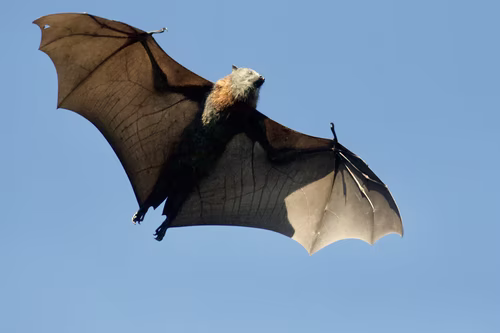Bats not only help keep mosquito populations in check but control populations of destructive insects like leaf hoppers, moths, and beetles. However, like any other animal, bats can become a nuisance and a danger to humans in certain circumstances.
California Myotis (Myotis californicus)
This bat species is one of North America’s smallest. California myotis bats roost beneath the loose bark of old trees and in rock crevices and buildings. Like most bats, the California Myotis will leave its roost to hunt for moths and flies during the night, returning at sunrise. Not fussy about where it roosts, it’ll use any shelter it finds, whether man-made or natural.
Little Brown Bat (Myotis lucifugus)
The little brown bat represents one of North America’s most common species. Roosting in colonies numbering in the thousands, this bat species is mainly found near lakes and streams. These bats hibernate during winter months and will nurse young bats in maternity colonies located in various structures..
Long-Legged Myotis (Myotis volans)

A bat species of special concern, the long-legged myotis typically prefers forests but is also found in desert environments. In addition to its long legs, this bat can also have a long life. Some in this bat species have been known to live as long as twenty-one years. Long-legged Myotis typically roost in large colonies of up to 300 individuals. They feed on moths, termites, wasps, and lacewings.
Mexican Free-Tailed Bat (Tadarida brasiliensis)
The Mexican free-tailed bat is one of the most common in California, as well as the most common species in all of the western hemisphere. This bat species roosts in a wide variety of places, including culverts and bridges, as well as trees, caves, and buildings. The Mexican free-tailed bat is famous for its colony sizes, which have been known to reach millions of individuals.
Pallid Bat (Antrozous pallidus)
A slower flier than most other bat species, the pallid bat is also a ground hunter. This bat feeds on crickets, grasshoppers, scorpions, and flightless beetles, and it has a wide range of calls, which include buzzing, clicking, and rasping. Pallid bats live in small colonies of 100 individuals at most, but they are easy to detect, thanks to glands on their muzzle which produce a skunk-like odor.
Western Pipistrelle (Pipistrellus hesperus)

Weighing in from 0.1 to 0.2 oz, the Western Pipistrelle is the United States’s smallest bat. It roosts in very small numbers of 12 individuals or less and lives between 10 and 13 years. This species prefers to roost near water in caves, under loose rocks, and in cliffs and canyons. Western Pipistrelles are also known to rise early, and they are seen hunting up to two hours before other bat species do.
Other commonly seen species include the big brown bat, red bat, hoary bat, Indiana bat, and Townsend’s big-eared bat.
What to Do if You See Bats Near Your Home
The best thing to do is to install bat boxes and bat houses. Bats that are roosting in your home should be removed, as they carry serious diseases that are transmissible to humans.
Observe your bat population for white nose syndrome, which can be recognized by a white color on the nose, as well as activity in winter. It spreads quickly and can kill numerous bats very rapidly. Therefore, it’s important to call a pest control service as soon as possible after noticing symptoms.
Animal Capture Wildlife Control has over 20 years of experience with bat removal. With a state trapping license from the Department of Fish and Wildlife, we ensure professional, reliable, timely, and humane removal. Learn more by reading our website.
